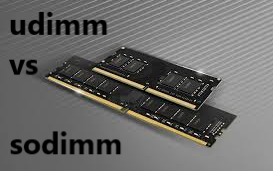In the bustling realm of computer components, a silent war rages between two titans: UDIMM and SODIMM. Both dance the delicate ballet of memory, feeding information to the insatiable processors that breathe life into our digital creations. But these champions, while sharing the stage, do so with distinct costumes and talents. So, before you blindly choose a champion for your tech battlefield, let’s unsheathe the differences between UDIMM and SODIMM, helping you find the perfect memory knight for your digital kingdom.
Table of Contents
UDIMM: The Stalwart Veteran
Think of UDIMM as the seasoned warrior, the trusty workhorse of the desktop world. These robust modules, with their 240 pins, stand tall in their DIMM slots, powering desktops and workstations with their reliable performance and generous capacities. They favor bandwidth, boasting higher frequencies and data transfer rates, ideal for intensive tasks like video editing and demanding games.
SODIMM: The Agile Scout
SODIMM, meanwhile, is the nimble scout, the stealthy infiltrator of laptops and mini PCs. These compact modules, with their 200 pins, squeeze into the smaller confines of portable devices, whispering sweet nothings of memory to hungry processors on the go. They prioritize power efficiency, drawing less juice to extend battery life, while still offering decent performance for everyday tasks and light gaming.
Distinguishing Their Banners
So, how do we tell these memory knights apart? Here’s a quick heraldry lesson:
- Size: UDIMM packs a larger punch, physically extending beyond SODIMM’s compact frame.
- Pin Count: UDIMM sports 240 pins, while SODIMM has 200, like a secret handshake for their respective devices.
- Performance: UDIMM muscles through bandwidth-hungry tasks, while SODIMM prioritizes efficiency for mobile warriors.
- Applications: UDIMM reigns supreme in desktops and workstations, while SODIMM infiltrates laptops and mini PCs.
Their Battlegrounds
Where do these warriors shine brightest? Here’s a glimpse into their domains:
- UDIMM: Desktop powerhouses, video editing rigs, high-performance workstations, and gaming PCs all welcome UDIMM’s robust presence.
- SODIMM: Laptops of all stripes, netbooks, ultra-thin PCs, and mini ITX builds find their perfect memory ally in the nimble SODIMM.
Speed and Latency: A Tactical Maneuver
While UDIMM generally boasts higher bandwidth, SODIMM can hold its own in everyday tasks. However, if raw speed and minimal latency are your battle cries, UDIMM often emerges victorious. For most users, though, SODIMM’s efficiency and portability provide a well-rounded balance.
Conclusion: Unmasking the Memory Monarch
The duel between UDIMM and SODIMM is not about pitting one against the other, but about understanding their unique strengths and choosing the champion that best serves your digital kingdom. Whether you’re a data-crunching desktop warrior or a nimble laptop knight, there’s a memory module perfectly suited to your needs.
Remember, UDIMM shines with its raw power and bandwidth, ideal for performance-hungry tasks. SODIMM, however, conquers the portable realm with its compact size and efficient operation. Ultimately, the ideal memory module is the one that empowers you to conquer your digital goals, seamlessly and efficiently. So, choose wisely, strategize brilliantly, and let your tech journey flourish under the reign of the perfect memory monarch!
FAQ
Can I use UDIMM in a laptop?
No, UDIMM’s size and pin configuration make it incompatible with laptops. Only SODIMM modules fit into the smaller slots of portable devices.
Does UDIMM always offer better performance than SODIMM?
While UDIMM generally boasts higher bandwidth, SODIMM can hold its own in everyday tasks. For most users, SODIMM’s efficiency and portability outweigh the slight performance difference.
Which brand of UDIMM or SODIMM should I choose?
Several reputable brands offer high-quality memory modules. Research individual reviews and compare specifications to find the one that best suits your needs and budget.
Can I upgrade the RAM in my laptop or desktop with a different type of module?
No, mixing UDIMM and SODIMM within the same device is not advisable. Always ensure compatibility by checking your device’s specifications or consulting the manufacturer.

John an experienced IT specialist with over a decade of experience in the industry. He holds a Bachelor’s degree in Computer Science and has worked in various positions, including software developer, system administrator, and network engineer. John’s expertise includes cloud computing, cybersecurity, and data analytics. He has completed numerous certifications in these areas and is highly knowledgeable in the latest technologies and trends.

